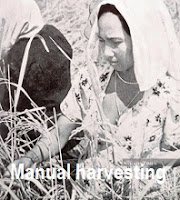The lack of progress was also caused by the farmers who did not see their work as an economic or business undertaking. For me as senior agronomist nowadays sees that to a majority the local paddy planting was a way of life where the village pawang paddy whose position was second only to the headman, or penghulu, was often called upon to conduct elaborate rituals to ensure successful planting cycles. These practices ten was faded after British interventions in the 1870s in which the colonial administrators considered these practices as hindrances to more efficient cultivation. Existence of pawang padi activities seen as a waste of time and money and were suppressed when state religious authorities declared that these animistic practices and beliefs were un-Islamic. Later the scientific methods became preeminent when district officers took over the pawang paddy's role of determining sowing, transplanting and include harvesting periods. Initial resistance to change dissipated when farmers realised that bountiful harvests were the result of controlled water supply rather than rituals. The tin mining and rubber cultivation booms in the late 19th century saw demand for rice increase sharply as Chinese and Indian immigrants arrived by the shipload. With only Kedah, Kelantan and Perlis recording harvest surpluses in which rice had to be imported from Siam (today Thailand), Burma (now Myanmar) and French Indochina (Laos, Cambodia and Vietnam today) to meet the rapid increase in demand.
Paddy needs lots of water to grow in which the irrigation technique needed. By then the colonial government's pro-Malay stance ensured that the rice industry continued receiving assistance. Apart from the passing of Malay Reservation Enactments in which set aside land for Malay ownership, this wide-ranging policy cemented the colonial government's belief in allowing peasants to continue living on the lands they owned and the food they grew rather than replacing their time-tested padi fields and orchards for uncertain new crops that fluctuated in demand and prices. As public knowledge, among rice-producing Malayan states such as Kedah was constantly at the forefront with nearly all Malay workers engaged in this industry. Grown on a commercial basis with the success or failure of the crop had an important bearing on state coffers. Lack of irrigation in the years leading up to the 1880s saw fields concentrate around Alor Star with others stretching as far inland as Langgar and northwards along the road to Perlis. On other record that the Sungai Tengi irrigation project contributed to the success of padi planting in Tanjung Karang, Selangor as a success story. In Kedah stated that eager to expand cultivation, Wan Muhammad Saman embarked on an ambitious project to build a 36km canal connecting Sungai Kedah in Alor Star, southwards to the Gunung Jerai foothills. Inspiration to turn vast swamplands into padi fields came after the first Kedah menteri besar saw how canals were used in Bangkok. Reported that many unpaid labourers, mobilised through the 'kerah system' has also succumbed to malaria. The swamps were so infested with mosquitoes that ropes securing mosquito nets were said to break under the weight of the insects landing on them at night. Although work began in August 1885 however progress was severely hampered when workmen abandoned their posts and escaped to Penang. Then left with no alternative Wan Muhammad Saman compensated the remaining workers with his savings and brought in Chinese labourers to work in the most challenging areas. Work progressed round the clock as the canal had to be ready before the next planting season. Thousands of jamung (bamboo torches) were lit at night so that work could continue. The line of lit torches also ensured that the canal was well aligned and followed the contours of the land so that water flowed unimpeded. Continue to read in Part 2. Thanks to NST reporters. Thanks...
M Anem,
Putrajaya,
Malaysia.
(December 2022).




No comments:
Post a Comment